Maybe your boss tasked you with creating a survey for your company and you ended up struggling with what to do. More importantly, you may have struggled with what not to do!
As with any type of research, there are some things that you should never (ever) do when designing or analyzing a survey.
Every survey has to follow certain guidelines to know who your respondents are and why they respond how they do. It’s important to know these rules to avoid mistakes that could change the answers you’re seeking or create biased results.
So before starting this important task, let’s take a look at what not to do!
How To Avoid Those Pesky Common Survey Mistakes
Surveys are a great way to gather information from respondents for different research and marketing purposes or a sneaky way of generating leads for your business. Surveys can be conducted online, through a company’s website, or on paper.
They compile responses as a list that you can use for analysis.
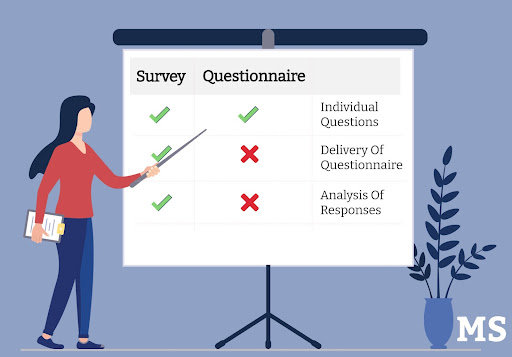
Image source: MarketSplash
The most common types of questions asked in a survey are related to a particular product or service that businesses try to collect more information about. They may be multiple-choice, rating scale, or demographic questions.
Surveys are useful when a business is struggling to enter a market or finds its product or service failing to meet consumer enthusiasm. Using a survey tool makes it easier to create effective surveys, however, there are a number of mistakes people still make. Here’s what not to do when creating surveys:
1. Don’t Skip Out on the Introduction
The intro of your survey is essential. It sets the tone for the rest of your survey. It also helps gather a point of view on what you’re trying to get out of the survey. It’s best to keep it short, sweet, and straight to the point!
Have some set questions to help you write an introduction. For instance, you could ask questions like,
- “Why am I making this survey?”
- “Who will use the results?”
- “How long will it take?”
Using introductory questions will help you explain the point of the survey.
2. Don’t Ask Too Many Questions
Don’t ask too many questions on a survey to gauge customer satisfaction or get feedback on specific things like marketing campaigns or brand perception.
Other ways to achieve those goals can avoid making your respondent think they have to answer every question out of sheer obligation and the pressure they feel to do so.
For instance, asking one or two questions is okay when you want opinions on a specific subject. But if you want an in-depth answer, you must make the survey longer.
3. Don’t Ask Multiple Open-Ended Questions
Open questions provide exciting responses but can confuse and defy your ability to segment the audience. If you use more than one open-ended question in a row, people will answer the first one and leave the survey.
It’s frustrating to read a question requiring more than a few words to answer. For example, think of each “question” as being like a page in a book. Each page should contribute something meaningful.
Your survey will probably have at least five questions, so each one should say something significant about your audience’s opinion.
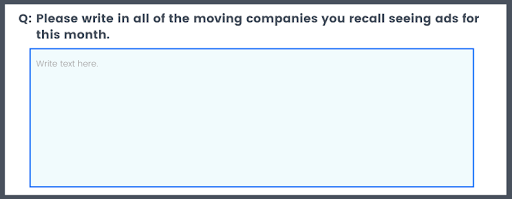
Image source: PollFish
4. Don’t Ask Double-Barreled Questions
Double-barreled questions are generally confusing for the respondent and lead to unclear answers. A classic example is “How satisfied were you with our service and staff demeanor?”
The question is actually asking two questions.
If you want to answer two questions with a single response, you must create two separate questions. You can link them together, but you cannot ask both questions simultaneously.
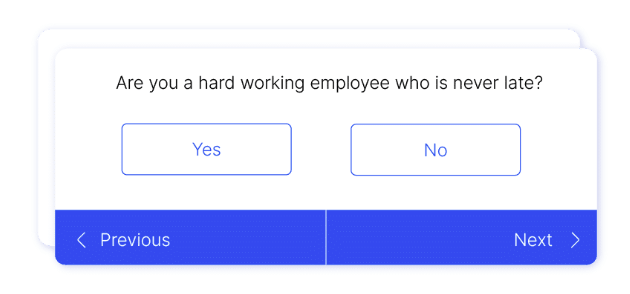
Image source: Voxco
5. Don’t Ask Leading Questions
Ask all the right questions, but don’t intimidate respondents by asking leading questions. For example, “I wonder how you feel about this?” is not a good survey question.
Leading questions may sway the respondent’s answer. What’s more, asking leading questions is often an invitation to form a subservient relationship with the respondent.
You can use questions that provide options for the respondent to choose from (e.g., “How do you feel about your choice of car?”).
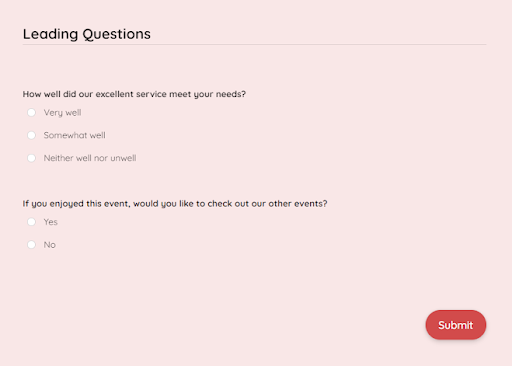
Image source: FormPlus
6. Don’t Use Absolutes
When creating a survey, you want to avoid using absolutes. Things like “always” and “never” can make people feel boxed into a specific response.
The correct way of saying the same thing would be, “How often do you…?” So instead of saying, for example, “Do you always come on time for work?” you can rephrase it as, “How often do you come on time for work?”
7. Don’t Focus Too Much on Aesthetics
Aesthetics are essential to the success of each survey, but the more areas you focus on, the more likely you are to run into a problem that can ruin your design. So while the design of your survey must be legible and offer a good user experience, adding extra elements purely for the fake of making it beautiful will only distract from the overall focus of the survey.
For example, you may be tempted to use that beautiful pastel color palette you’ve had your eye on or an eye-catching animation or two, but don’t. Keep it simple and functional.
8. Don’t Create a Survey Without an End Goal in Mind
Don’t just create a survey because you think it’d be fun to do so. You need to have a goal in mind when you start designing your survey. The purpose of your survey forms is to determine where your customers stand regarding the subject matter or a problem you’re trying to solve.
Write measurable goals for each question and the number of responses required to help you know exactly what you need for your survey to succeed.
Set a clear goal and offer a purpose. For example, if you are seeking information about payment plans, you should begin with: “We are looking for payment options that work for our users, so we created this survey.”
9. Don’t Forget a “Prefer Not To Say” Option
One of the primary purposes of creating a survey is to derive data for decision-making. To do this, you need clear answers. Don’t force your respondents into answering a question they don’t want to answer or won’t answer honestly.
Giving people this option gives you more data, but it also gives them a sense of security. If they don’t want to be judged for their answers or simply don’t want to answer for whatever reason, they can use it as a way out.
Having the option not to answer prevents respondents from feeling forced into answering questions when they would rather not. For instance, not everyone is comfortable answering questions about their income.
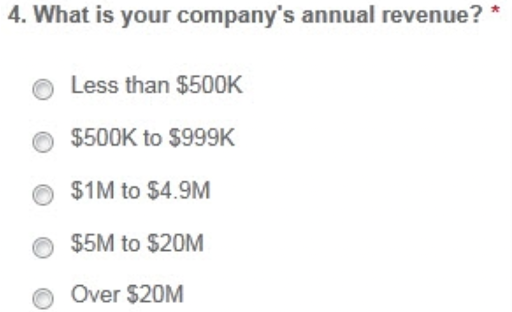
Image source: Genroe
10. Don’t Be Vague
Even a survey that is as broad as possible needs to be specific. Generalizing your questions will make it hard for you to get tangible results from the data you collect. Ensure your survey has detailed questions with specific answers. Below is an example of a vague and distinct question.
- The vague question: “How useful was this article?”
- The specific question: “On a scale of 1 to 10, how useful was this article?”
11. Don’t Use Unbalanced Or Unclear Scales
Make sure to use a balanced scale. Unbalanced scales are not evenly distributed along the continuum of the question they’re supposed to measure.
If the choices are only positive or negative, people will not know how to respond if they don’t fall into one of those categories.
Here’s an example. “I like this” and “I do not like this at all” are completely unbalanced because one end of the scale is positive and the other is negative. A survey using this scale is never helpful because it will always create a false dichotomy.
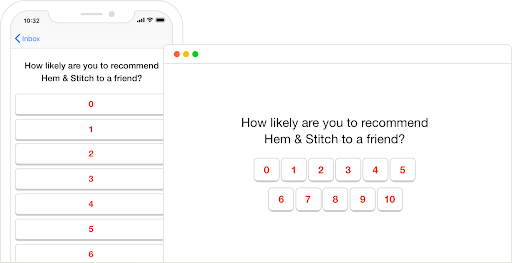
Image source: Delighted
12. Don’t Forget To Order Your Questions Logically
When thinking of an order for your questions, don’t forget to think about how they relate. You will often try to collect information on several topics, and you need to place questions in the correct sequence that makes sense.
For example, if you’re developing a survey to collect information on what types of products customers prefer and like the most, ask the participants about their favorite kind of product, then follow up by asking them about their second favorite type.
Remember that this doesn’t only apply to ordering questions but also to deciding which questions to add or remove.
13. Don’t Bring Emotion Into The Survey
We’ve all had experiences with surveys, and what can be a wonderful experience for some can lead to horrible ones for others. One of the worst things you can do when creating a survey is to create emotional responses from your respondents.
Remember to only ask questions that convey factual information and leave the emotional component out. If you feel you must ask for an opinion, be sure to present your facts as neutrally as possible.
Questions like “Do you hate/love cars?” will likely end up with answers about hating cars if a respondent just totaled their car and hates the person who hit them.
14. Don’t Use Unclear or Unpopular Language
Many people use survey creation software to help them easily create a survey, but the pre-made questions are not always ideal for obtaining information.
Additionally, remember that people don’t always read through everything before clicking, so the language of your survey must be clear and easy to understand.
Also, avoid using words or phrases that some people find “unpopular.” Even if they are common words or phrases, they might not resonate with someone, resulting in a less-than-successful response.
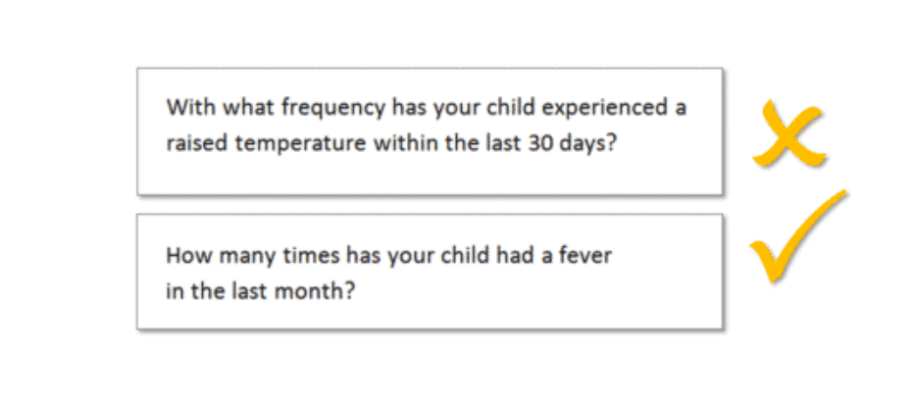
Image source: Tools4Devs
15. Don’t Use Jargon or Acronyms
Surveys are simple forms of communication. You want to ensure that the people who take your survey understand exactly what you’re asking in an everyday language. You don’t want to use acronyms or any jargon they won’t understand, as that would skew the results of your survey and make them useless.
Think about how words sound and keep that in mind when writing surveys. You wouldn’t ask someone, “Hey, wanna go shopping?” in a survey. Instead, you would say, “What are some ways we can improve our brands’ appeal?”
Summary
Data is the new currency, and surveying the masses is a key way to collect important insights and generate potential leads for your business.
However, to get good data from your surveys, you need to know what not to do.
For a survey to be successful, it must include a well-crafted questionnaire. The above tips are some great ways to help your next survey successfully gather the data you need.







